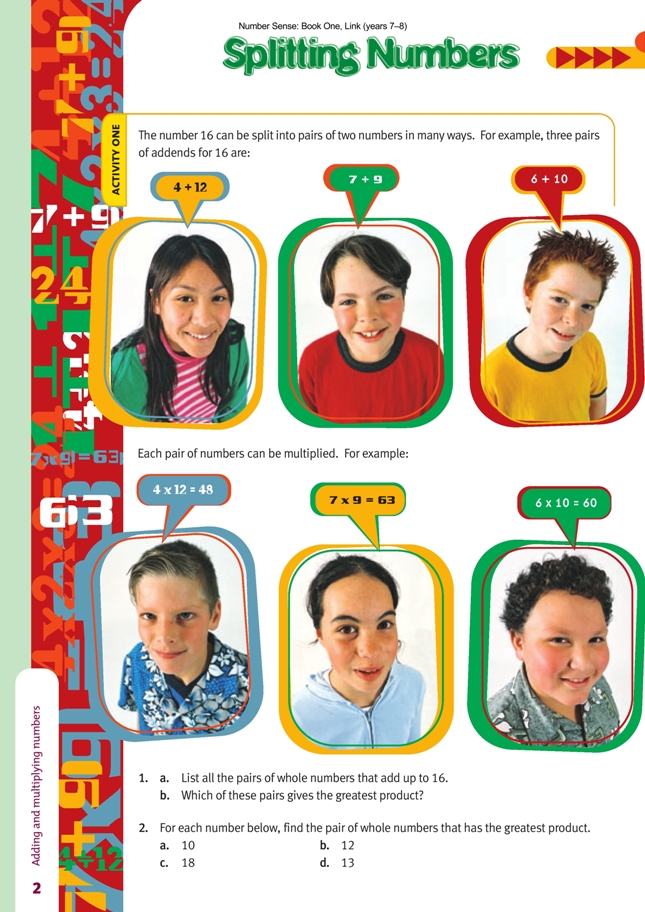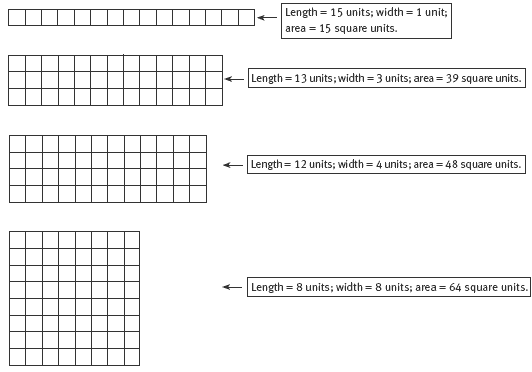This is a level 3 number activity from the Figure It Out series. It relates to Stage 6 of the Number Framework.
A PDF of the student activity is included.
Click on the image to enlarge it. Click again to close. Download PDF (671 KB)
use multiplication facts to solve problems
Activity One
This is a step-by-step investigation that relates to an interesting connection with another area of mathematics, that is, the relationship between the dimensions of a rectangle and its area.
The two addends that a number is split into can be visualised as representing the length and width of a rectangle. By multiplying the addends together, we are finding the area of that rectangle. Show the students diagrams of the rectangles provided below to help them see how the area of a rectangle changes as the length and width change.
Some rectangles where the length + width equals 16 units are:
Question 2d gives an odd number, so the whole numbers that result in the greatest product have a difference of 1. Thirteen is split into 7 and 6 to give the greatest product, which is 42.
As an extension to this question, have the students split 13 into two equal addends using fractions. This would be 6.5 + 6.5. The product of these two numbers is 42.25.
From this, the students should conclude that a square rectangle always has a greater area than an oblong rectangle that has been made by splitting a number.
Activity Two
This activity extends the previous investigation by looking at three-addend splits. This can be visualised as comparing the dimensions of a rectangular prism with its volume. Again, the students should find that the prism with sides that are equal in length (that is, a cube) yields the greatest volume.
Question 3 in this activity is the real goal of this investigation. Explain this to the students and show them how the investigation is structured to lead them to this question. Some students may wish to extend this still further to see if this pattern applies with four or more splits.
Students who have grasped the idea could be challenged to investigate multiplication using a calculator. “How can the keys 2 , 3 , 4 , 5 , and x be pressed once each time to make the largest product?” The factors that do this are 52 x 43 because these digits are the nearest to making the dimensions of a square.
Answers to Activity
Activity One
1. a. 15 + 1, 14 + 2, 13 + 3, 12 + 4, 11 + 5, 10 + 6, 9 + 7, 8 + 8
b. 8 and 8 (because 8 x 8 = 64)
2. a. 5 + 5 (because 5 x 5 = 25)
b. 6 + 6 (because 6 x 6 = 36)
c. 9 + 9 (because 9 x 9 = 81)
d. 6 + 7 (because 6 x 7 = 42)
Activity Two
1. 3 + 3 + 3 because 3 x 3 x 3 = 27. (The other sets are: 1 + 1 + 7, 1 + 2 + 6, 1 + 3 + 5, 1 + 4 + 4, 2 + 2 + 5, 2 + 3 + 4.)
2. a. 4 + 4 + 4 (because 4 x 4 x 4 = 64)
b. 5 + 5 + 5 (because 5 x 5 x 5 = 125)
c. 6 + 6 + 6 (because 6 x 6 x 6 = 216)
d. 6 + 7 + 7 (because 6 x 7 x 7 = 294)
3. Yes. You get the greatest product when each set of two or three numbers consists of whole numbers that are the same or nearly the same. (If you were using fractions instead of whole numbers only, with 13 you would get 6 1/2 x 6 1/2 = 42 1/4 as the greatest product instead of 6 x 7 = 42, and with 20, you would get 6 2/3 x 6 2/3 x 6 2/3 = 296.296, instead of 6 x 7 x 7 = 294.)


